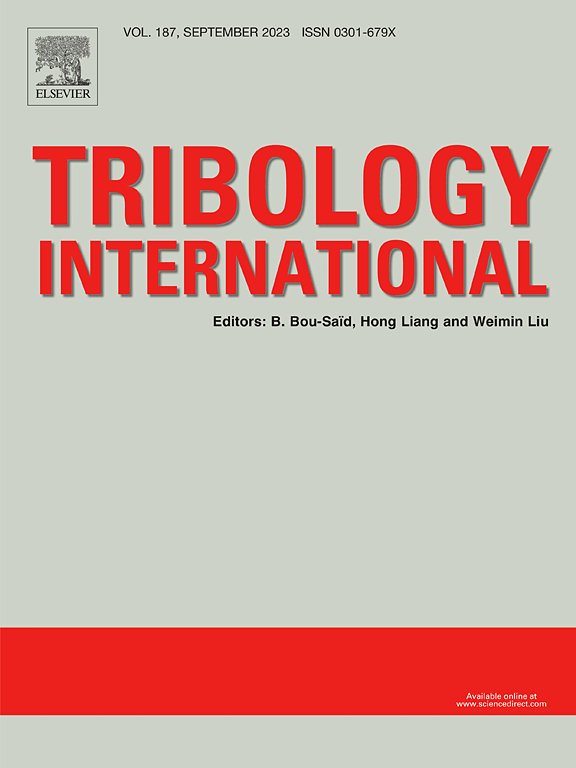硬质合金刀具加工Inconel 718刀具磨损的多尺度预测建模
IF 6.1
1区 工程技术
Q1 ENGINEERING, MECHANICAL
引用次数: 0
摘要
刀具磨损的准确预测为研究刀具磨损对切削性能的影响和降低实际生产成本提供了很好的机会。然而,作为一个复杂的过程,刀具磨损的准确预测仍然是一个具有挑战性的项目。采用耦合欧拉-拉格朗日(CEL)有限元法对Inconel718切削过程中刀具磨损进行了二维建模和仿真研究。基于温度效应,综合考虑磨粒磨损、黏着磨损和扩散磨损机理,建立了硬质合金刀具磨损率的数学模型。结合热硬度数据,重点研究磨粒运动方式下磨粒磨损对磨粒磨损率的影响,建立了切削过程中磨粒磨损率的数学模型。在刀面磨损预测中,刀具刀面体积损失与磨损率相关,并基于温度效应建立相应的刀面磨损数学模型。最后,利用Python语言对ABAQUS进行二次开发,编写刀具磨损子程序,从ABAQUS输出数据库中提取相关参数,计算刀具磨损率。通过研究刀具前刀和刀面磨损几何形状的演变以及刀具前刀和刀面磨损的变化,并通过正交车削试验对刀具磨损进行观察和分析,验证了所建立的刀具磨损模型的准确性,实现了对刀具磨损的预测。与试验结果比较,刀具磨损预测误差小于15 %。本文提出的刀具磨损率方程和切削模型有助于提高切削过程中刀具磨损的预测精度。本文章由计算机程序翻译,如有差异,请以英文原文为准。
Multi-scale predictive modeling of tool wear for machining Inconel 718 with cemented carbide tools
Accurate prediction of tool wear offers great opportunity to study the effects of tool wear on cutting performance and to reduce real production costs. However, as a complex process, the accurate prediction of tool wear remains a challenging project. In this paper, the 2D modeling and simulation of tool wear during cutting Inconel718 are studied by using the coupled Euler-Lagrange (CEL) finite element method. Based on the temperature effect, a mathematical model of the wear rate of cemented carbide tools was established with comprehensive consideration of the abrasive, adhesive, and diffusive wear mechanisms. The corresponding mathematical model of abrasive wear rate was established during cutting by combining with the thermal hardness data and focusing on the influence of the abrasive wear in the abrasive grain movement mode on the wear rate. In the prediction of flank wear, the volume loss of the tool flank surface is related to the wear rate, and the corresponding mathematical model of flank wear is established based on temperature effect. Finally, the secondary development of ABAQUS is carried out using Python language, and tool wear subroutine is written to extract relevant parameters from the ABAQUS output database to calculate the tool wear rate. Through studying the evolution of the geometric shape of the rake and flank tool face wear and the change of the rake and tool flank face wear, and the orthogonal turning test which is carried out to observe and analyze the tool wear, the accuracy of the established tool wear model was verified to achieve the prediction of the tool wear. Compared with the test results, the prediction error of tool wear is less than 15 %. The equation of tool wear rate and cutting model proposed in this paper are helpful to improve the prediction accuracy of tool wear in cutting process.
求助全文
通过发布文献求助,成功后即可免费获取论文全文。
去求助
来源期刊

Tribology International
工程技术-工程:机械
CiteScore
10.10
自引率
16.10%
发文量
627
审稿时长
35 days
期刊介绍:
Tribology is the science of rubbing surfaces and contributes to every facet of our everyday life, from live cell friction to engine lubrication and seismology. As such tribology is truly multidisciplinary and this extraordinary breadth of scientific interest is reflected in the scope of Tribology International.
Tribology International seeks to publish original research papers of the highest scientific quality to provide an archival resource for scientists from all backgrounds. Written contributions are invited reporting experimental and modelling studies both in established areas of tribology and emerging fields. Scientific topics include the physics or chemistry of tribo-surfaces, bio-tribology, surface engineering and materials, contact mechanics, nano-tribology, lubricants and hydrodynamic lubrication.
 求助内容:
求助内容: 应助结果提醒方式:
应助结果提醒方式:


